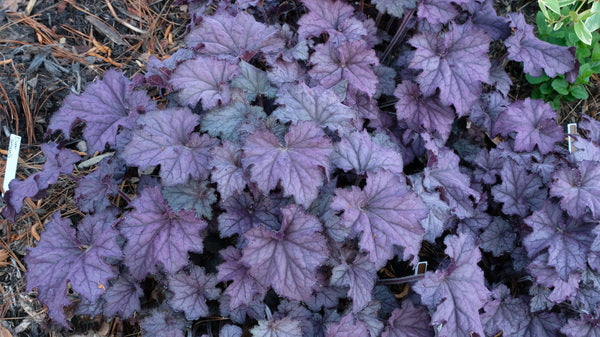Heuchera 'Grande Amethyst' PP 30,932
Grande Amethyst Coral Bells
Item #: 14350
Zones: 4a to 8a
Dormancy: Evergreen
Height: 16" tall
Culture: Part Sun to Light Shade
Origin: United States Hybrid
Pot Size: 3.5" pot (24 fl. oz/0.7 L)
(aka: Heuchera 'TNHEUGA') Through the last few decades, we have trialed 227 different coral bells, so we know a winner...and a loser when we see them. We have been blown away with the performance of Terra Nova's new coral bell, Heuchera 'Grande Amethyst'. This giant coral bell forms a 16" tall x 3' wide clump that's dramatically larger that most clones on the market. For two years, it has thrived in our heat and humidity trials, moving it up to the top echelon of our trialed coral bell varieties for tough summer climates. The rich violet evergreen foliage is highlighted by black-purple veins, and topped by spikes of small pink flowers in late spring. We have even trialed this in 2-3 hours of morning sun, where it has thrived.
Maintenance:
Heuchera 'Grande Amethyst' is a relatively maintenance free perennial. After flowering is finished, we like to cut back the old flower stalks, for a tidier appearance, but it has not effect on the growth of the plant.
Heucheras by nature are short-lived perennials, with a life expectancy of 5-7 years. When plants begin to decline, they can be lifted, divide, and reset, to start the clock ticking again. We have had the best success doing this in fall, but most likely other seasons will work as well.
Growing Conditions:
Good drainage is the key to growing heuchera successfully. Good drainage does not mean the plants cannot tolerate irrigation or rainfall, just that the moisture must drain away quickly. Light shade to a couple of hours of early morning sun works best, although we have found this exceptional cultivar to tolerate more sun than any other cultivar we have tried. Deep shade is not conducive to growing good coral bells.
Natural Impacts:
Bees and to a lesser extent hummingbirds are the main pollinators that you're likely to see on your 'Grande Amethyst'.


-
Other Attributes
Genus: Heuchera
Flower Color: Pink , Purple/Lavender
Leaf Color: Black , Purple/Lavender
Garden Themes: Cottage Garden Plants , Living Wall , Rock Garden Plants
Other: Cut Flower Plants , Drought Tolerant Plants , Dry Shade Plants , Groundcovers , Hummingbird Plants , Pollinator Plants , North American Native Plants , Plants that Attract Birds , Rabbit Resistant Plants , Salt Tolerant Seaside Plants , Colored Foliage , Patterned Foliage , Tony's Favorites , United States Native Plants




